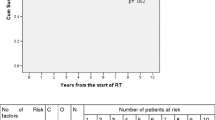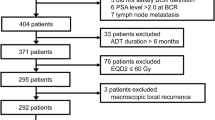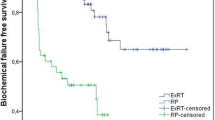Abstract
Purpose
To validate the clinical outcomes and prognostic factors in prostate cancer (PCa) patients with Gleason score (GS) 8–10 disease treated with external beam radiotherapy (EBRT) + androgen deprivation therapy (ADT) in the modern era.
Methods
Institutional databases of biopsy proven 641 patients with GS 8–10 PCa treated between 2000 and 2015 were collected from 11 institutions. In this multi-institutional Turkish Radiation Oncology Group study, a standard database sheet was sent to each institution for patient enrollment. The inclusion criteria were, T1–T3N0M0 disease according to AJCC (American Joint Committee on Cancer) 2010 Staging System, no prior diagnosis of malignancy, at least 70 Gy total irradiation dose to prostate ± seminal vesicles delivered with either three-dimensional conformal RT or intensity-modulated RT and patients receiving ADT.
Results
The median follow-up time was 5.9 years (range 0.4–18.2 years); 5‑year overall survival (OS), biochemical relapse-free survival (BRFS) and distant metastases-free survival (DMFS) rates were 88%, 78%, and 79%, respectively. Higher RT doses (≥78 Gy) and longer ADT duration (≥2 years) were significant predictors for improved DMFS, whereas advanced stage was a negative prognosticator for DMFS in patients with GS 9–10.
Conclusions
Our results validated the fact that oncologic outcomes after radical EBRT significantly differ in men with GS 8 versus those with GS 9–10 prostate cancer. We found that EBRT dose was important predictive factor regardless of ADT period. Patients receiving ‘non-optimal treatment’ (RT doses <78 Gy and ADT period <2 years) had the worst treatment outcomes.
Zusammenfassung
Ziel
Beurteilung der klinischen Ergebnisse und prognostischen Faktoren bei Patienten mit Prostatakrebs (PCa) mit Gleason-Score (GS) 8–10, die mit externer Strahlentherapie (EBRT) und einer Androgendeprivationstherapie (ADT) behandelt wurden.
Methoden
Zwischen 2000 und 2015 wurden insgesamt 641 mittels Biopsie diagnostizierte PCa-Patienten mit GS 8–10 von 11 Instituten in die Studie einbezogen. In dieser multizentrischen Studie der Turkish Radiation Oncology Group wurde ein Standard-Datenbankformular zur Patientenaufnahme an jedes Zentrum geschickt. Die Einschlusskriterien waren: keine vorherige Diagnose von Malignitäten, T1–T3 N0 M0 gemäß der TNM-Klassifikation des AJCC (American Joint Committee on Cancer) von 2010 und eine RT von Prostata und Samenblasen mindestens bis 70 Gy entweder mit dreidimensionaler oder mit intensitätsmodulierter RT zusammen mit einer ADT.
Ergebnisse
Die mediane Nachbeobachtungszeit betrug 5,9 Jahre (Spanne 0,4–18,2 Jahre). Das 5‑Jahres-Gesamtüberleben (OS), die biochemische Rezidivrate (BCR) und das fernmetastasenfreie Überleben (FÜ) der Patienten mit einer Nachbeobachtungszeit von 5 Jahren betrug jeweils 88%, 78% und 79%. Höhere Dosis der RT (≥78 Gy) und langfristige ADT waren signifikante Prädiktoren für ein verbessertes FÜ. Fortgeschrittenes Stadium bei Patienten mit GS 9–10 wurde als negativer Prognosefaktor für das FÜ identifiziert.
Schlussfolgerung
Unsere Ergebnisse zeigen, dass sich die onkologischen Ergebnisse zwischen GS 8 und GS 9–10 bei Patienten mit PCa, die mit EBRT behandelt wurden, unterscheiden. Die EBRT-Dosis erwies sich als wichtiger prädiktiver Faktor unabhängig von ADT. Patienten, die keine optimale Behandlung erhielten (RT mit Dosen <78 Gy und ADT-Zeit <2 Jahre), hatten die schlechtesten Behandlungsergebnisse.



Similar content being viewed by others
References
Siegel RL, Miller KD, Jemal A (2018) Cancer statistics, 2018. Ca Cancer J Clin 68(1):7–30
Kishan AU et al (2018) Radical prostatectomy, external beam radiotherapy, or external beam radiotherapy with Brachytherapy boost and disease progression and mortality in patients with Gleason score 9–10 prostate cancer. JAMA 319(9):896–905
Boorjian SA et al (2011) Long-term survival after radical prostatectomy versus external-beam radiotherapy for patients with high-risk prostate cancer. Cancer 117(13):2883–2891
Tilki D et al (2018) Surgery vs radiotherapy in the management of biopsy Gleason score 9–10 prostate cancer and the risk of mortality. Jama Oncol. https://doi.org/10.1001/jamaoncol.2018.4836
Zelefsky MJ et al (2010) Metastasis after radical prostatectomy or external beam radiotherapy for patients with clinically localized prostate cancer: a comparison of clinical cohorts adjusted for case mix. J Clin Oncol 28(9):1508–1513
Epstein JI (2010) An update of the Gleason grading system. J Urol 183(2):433–440
Tsao CK et al (2015) Patients with biopsy Gleason 9 and 10 prostate cancer have significantly worse outcomes compared to patients with Gleason 8 disease. J Urol 194(1):91–97
Epstein JI et al (2016) The 2014 International Society of Urological Pathology (ISUP) consensus conference on Gleason grading of prostatic carcinoma: definition of grading patterns and proposal for a new grading system. Am J Surg Pathol 40(2):244–252
Epstein JI et al (2016) A contemporary prostate cancer grading system: a validated alternative to the Gleason score. Eur Urol 69(3):428–435
D’Amico AV et al (1998) Biochemical outcome after radical prostatectomy, external beam radiation therapy, or interstitial radiation therapy for clinically localized prostate cancer. JAMA 280(11):969–974
Pierorazio PM et al (2013) Prognostic Gleason grade grouping: data based on the modified Gleason scoring system. BJU Int 111(5):753–760
Van Poppel H, Joniau S (2008) An analysis of radical prostatectomy in advanced stage and high-grade prostate cancer. Eur Urol 53(2):253–259
Loeb S et al (2016) Evaluation of the 2015 Gleason grade groups in a nationwide population-based cohort. Eur Urol 69(6):1135–1141
Ham WS et al (2017) New prostate cancer grading system predicts long-term survival following surgery for Gleason score 8–10 prostate cancer. Eur Urol 71(6):907–912
Wang C et al (2017) External beam radiation therapy with a Brachytherapy boost versus radical prostatectomy in Gleason pattern 5 prostate cancer: a population-based cohort study. Int J Radiat Oncol Biol Phys 98(5):1045–1052
Kalbasi A et al (2015) Dose-escalated irradiation and overall survival in men with Nonmetastatic prostate cancer. Jama Oncol 1(7):897–906
Bolla M et al (2016) Short androgen suppression and radiation dose escalation for intermediate- and high-risk localized prostate cancer: results of EORTC trial 22991. J Clin Oncol 34(15):1748–1756
Horwitz EM et al (2008) Ten-year follow-up of radiation therapy oncology group protocol 92-02: a phase III trial of the duration of elective androgen deprivation in locally advanced prostate cancer. J Clin Oncol 26(15):2497–2504
Kuban DA et al (2011) Long-term failure patterns and survival in a randomized dose-escalation trial for prostate cancer. Who dies of disease? Int J Radiat Oncol Biol Phys 79(5):1310–1317
Zapatero A et al (2015) High-dose radiotherapy with short-term or long-term androgen deprivation in localised prostate cancer (DART01/05 GICOR): a randomised, controlled, phase 3 trial. Lancet Oncol 16(3):320–327
Denham JW et al (2014) Short-term androgen suppression and radiotherapy versus intermediate-term androgen suppression and radiotherapy, with or without zoledronic acid, in men with locally advanced prostate cancer (TROG 03.04 RADAR): an open-label, randomised, phase 3 factorial trial. Lancet Oncol 15(10):1076–1089
Roach M 3rd et al (2006) Defining biochemical failure following radiotherapy with or without hormonal therapy in men with clinically localized prostate cancer: recommendations of the RTOG-ASTRO Phoenix Consensus Conference. Int J Radiat Oncol Biol Phys 65(4):965–974
Djaladat H et al (2017) Oncological outcomes after radical prostatectomy for high-risk prostate cancer based on new Gleason grouping system: a validation study from university of southern california with 3,755 cases. Prostate 77(7):743–748
Pompe RS et al (2017) Population-based validation of the 2014 ISUP Gleason grade groups in patients treated with radical prostatectomy, Brachytherapy, external beam radiation, or no local treatment. Prostate 77(6):686–693
Yang DD et al (2019) Androgen deprivation therapy and overall survival for Gleason 8 versus Gleason 9–10 prostate cancer. Eur Urol 75(1):35–41
Spratt DE et al (2016) Independent validation of the prognostic capacity of the ISUP prostate cancer grade grouping system for radiation treated patients with long-term follow-up. Prostate Cancer Prostatic Dis 19(3):292–297
Berney DM et al (2016) Validation of a contemporary prostate cancer grading system using prostate cancer death as outcome. Br J Cancer 114(10):1078–1083
He J et al (2017) Validation of a contemporary five-tiered Gleason grade grouping using population-based data. Eur Urol 71(5):760–763
Zietman AL et al (2005) Comparison of conventional-dose vs high-dose conformal radiation therapy in clinically localized adenocarcinoma of the prostate: a randomized controlled trial. JAMA 294(10):1233–1239
Kuban DA et al (2008) Long-term results of the M. D. Anderson randomized dose-escalation trial for prostate cancer. Int J Radiat Oncol Biol Phys 70(1):67–74
Amini A et al (2016) Survival outcomes of dose-escalated external beam radiotherapy versus combined Brachytherapy for intermediate and high risk prostate cancer using the national cancer data base. J Urol 195(5):1453–1458
Roach M 3rd et al (2003) Phase III trial comparing whole-pelvic versus prostate-only radiotherapy and neoadjuvant versus adjuvant combined androgen suppression: Radiation Therapy Oncology Group 9413. J Clin Oncol 21(10):1904–1911
Lawton CA et al (2007) An update of the phase III trial comparing whole pelvic to prostate only radiotherapy and neoadjuvant to adjuvant total androgen suppression: updated analysis of RTOG 94-13, with emphasis on unexpected hormone/radiation interactions. Int J Radiat Oncol Biol Phys 69(3):646–655
Pommier P et al (2016) Is there a role for pelvic irradiation in localized prostate Adenocarcinoma? Update of the long-term survival results of the GETUG-01 randomized study. Int J Radiat Oncol Biol Phys 96(4):759–769
Blanchard P et al (2016) Outcome according to elective pelvic radiation therapy in patients with high-risk localized prostate cancer: a secondary analysis of the GETUG 12 phase 3 randomized trial. Int J Radiat Oncol Biol Phys 94(1):85–92
Nabid A et al (2018) Duration of androgen deprivation therapy in high-risk prostate cancer: a randomized phase III trial. Eur Urol 74(4):432–441
Author information
Authors and Affiliations
Corresponding author
Ethics declarations
Conflict of interest
G. Ozyigit, C. Onal, S. Igdem, Z.A. Alicikus, A. Iribas, M. Akin, D. Yalman, I. Cetin, M.G. Aksu, B. Atalar, F. Dincbas, P. Hurmuz, O.C. Guler, B. Aydin, F. Sert, C. Yildirim, I.B. Gorken, F.Y. Agaoglu, A.F. Korcum, D. Yuce, S. Ozkok, E. Darendeliler and F. Akyol declare that they have no competing interests.
Rights and permissions
About this article
Cite this article
Ozyigit, G., Onal, C., Igdem, S. et al. Treatment outcomes of prostate cancer patients with Gleason score 8–10 treated with definitive radiotherapy. Strahlenther Onkol 195, 882–893 (2019). https://doi.org/10.1007/s00066-019-01476-z
Received:
Accepted:
Published:
Issue Date:
DOI: https://doi.org/10.1007/s00066-019-01476-z
Keywords
- Pelvic radiotherapy
- Grading system
- Intensity modulated radiation therapy
- Hormonal treatment
- Androgen deprivation therapy




